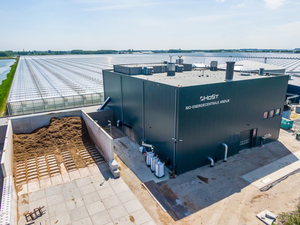A new biomass-fired combined-heat-and-power (CHP) plant has recently been commissioned in Andijk, the Netherlands for the production of heat and electricity from prunings. Independently conducted emission measurements, certified by a public authority, show that this clean biomass plant emits very little emissions. The plant has successfully completed the first heating season.

These measurements also showed that, thanks to the cleaning techniques applied, it is possible to combust biomass with considerably lower NOx emissions (nitrogen oxides) compared to firing fossil natural gas. The NOx emission standard for biomass energy plants is 145 milligrams per normal cubic meter of flue gas. Natural gas boilers emit 70 milligrams per normal cubic meter of flue gas. Recent measurements show that the biomass power station in Andijk emits very little NOx: less than 3 milligrams per normal cubic meter of flue gas. This is achieved with a relatively small higher investment of 2-3 percent.
Guaranteed low emissions
HoSt, designer and supplier of the biomass-fired energy plant, guarantees NOx emissions of no higher than 30 milligrams per normal cubic meter of flue gas. The heat supplied by this plant is then already produced with 60 percent less NOx compared to natural gas boilers. Once the flue gases are introduced into the greenhouses of the surrounding greenhouse area, the current gas engines will also go out of operation and NOx emissions will be reduced by approximately 90 percent. The flue gases are already clean enough to, in the near future, inject directly into the greenhouses for the necessary CO2 fertilization for the growth of the crops. The emission values, measured by the independent and government-certified company ‘Emissie- en Luchtkwaliteitsmetingen B.V’ (Emission and Air Quality Measurements B.V.), show that the practical values are much lower.
Other emissions are also very low. The dust emission is only 0.5 milligram per normal cubic meter, where large incineration plants (WIP) must meet the requirement of 5 milligrams per normal cubic meter. CxHy (hydrocarbons) emission is below detection level. The CO (carbon dioxide) is comparable to the CO emission of a natural gas boiler. The WIPs in the Netherlands meet strict environmental standards and use clean combustion techniques. The measurements of the Andijk bioenergy plant show that this plant fires cleaner on all fronts: values are achieved that are up to 90 percent lower than the limit values that an AVI must meet.
The biomass that is fired in these bioenergy plants originate from the Netherlands. This is in contrast to wood pellets that are imported. In fact. Data from Probos, a foundation that is committed to sustainable forest management and a sustainable wood sector, shows that nearly 40 percent of the Dutch biomass is exported and not used in its own country. In addition to wood, there are many residual flows in the Netherlands that are not used. The biomass plant in Andijk is future-proof designed. Other biomass, such as reed, clearing waste from greenhouses and paper sludge, can also be incinerated in the future.
In the Netherlands, trees are not cut down for the production of wood chips. Wood is expensive in the first place. The cost of wood chips is around €35 to €40 per ton, while the cost of shelves is more than €1,000 per ton. Cut trees do not have a shredding company as final destination, but are used at sawmills and in the paper industry. Biomass intended for small biomass plants (less than 20 MWt) originate from prunings, road and park maintenance, composting plants and from sawmills. In addition, to preserve certain landscape elements, such as wooded banks, moors and protected plants, maintenance is necessary that also results in useful biomass. The pruned wood used is always certified with the sustainability certificate NTA8080, which is issued by an independent auditor. An annual audit is part of the procedure. The European Union recognizes this certificate and it complies with the requirements of the Renewable Energy Directive. This certificate ensures that the wood is sustainably produced, processed and traded. This is in contrast to biomass intended for co-firing in coal-fired power stations or in wood pellet-fired boilers. That type of biomass is imported.
Most economical & clean solution
Admittedly, a higher investment is required for the realization of this bioenergy plant than it would require for a conventional biomass boiler. But it is a great leap forward. And an indispensable contribution to the energy transition and to the independence of fossil natural gas (in general and from the Groningen gas field in the Netherlands). It is the long-term environmental, social and political-administrative wish that the greenhouse horticulture sector and other sectors become more sustainable. This clean biomass plant provides the surrounding greenhouse horticulture with clean energy and, moreover, the necessary CO2 fertilization in the future. Producing heat and electricity with a modern biomass plant can be done at around 5 ct / kWh, enabling it to be one of the most economical solutions to achieve CO2 emission reduction.